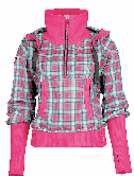Activewear’s going through a reflective phase
Published 4:00 am Thursday, December 9, 2010

- Exercise apparel, like this neon jacket from Brooks, is showing a new emphasis on visibility.
When City Sports wanted to draw more attention to its window displays this fall, the exercise apparel chain turned to the most eye-catching stuff in stock: highlighter-hued clothes in fluorescent yellow and orange, splashed generously with silvery reflective spots.
It’s turned out to be a bright idea, says Michael Mosca, executive vice president of merchandising, because urban athletes need neon. “In D.C., a lot of them are running on The Mall in the early morning,” he says. “It makes sense to be dressing in high-visibility clothing.”
And it makes fashion sense, too. For years, the only option for anyone fearing a future as road kill was donning one of those crossing guard-inspired vests. But manufacturers are finally turning out stuff designed to be seen that you’re not embarrassed to be seen in.
“The idea is to make it something that fits well, wicks and breathes,” Mosca adds.
City Sports is raising awareness through its run clubs, including a recent reflectivity-themed night to introduce customers to what to wear in low-light conditions.
It’s been shoppers doing the educating at Lululemon, which was flooded with requests for reflective gear. So this summer, the brand launched “Run: Reflection,” a line of pieces made with a fabric woven with reflective yarns so “it looks like you’re shimmering,” describes Amanda Casgar, Lululemon’s regional community guru.
Non-traditional cuts — including a racer-back vest ($98) — and wild plaid patterns are aiming to make safety chic. “We’re not in the business of making hideous clothing,” adds Casgar, who notes that more items, including shorts and a pullover, will be available in stores by Thanksgiving.
Will this be a fitness fad that just runs its course? Not according to Mosca. “This is what we’ll be carrying going forward,” he says.
That probably includes Under Armour’s new line of run wear that made its debut at the Baltimore Running Festival earlier this month. Marathoners and staff sported shirts in a super bright yellow, which will be all over jackets, half-zips and other garments scheduled to be on sale starting in January.
That’s one high-visibility way to promote high visibility.
Reflective refuseniks often believe they’re fine outside as long as they’re not dressed like ninjas. “We’ve all heard not to wear all black,” says Shari Franklin-Smith, a reflectivity expert for 3M.
But she doesn’t give light-colored fabrics glowing reviews, either, since they’re still only visible from 300 feet. That’s why 3M is pushing a new campaign, “No White At Night,” featuring a video proving how hard it can be to spot runners without reflective attire, along with products that boast its “360 degree enhanced visibility” standard.
“If you’re running at a 90 degree-angle to traffic, and it’s all on the front or back, the person isn’t visible,” Franklin-Smith explains.
Although it would be possible to make a garment entirely out of reflective material, less is more. When there are bits of reflectivity at biomotion points, “the brain can fill in that’s a person,” Franklin-Smith says. A completely reflective blob might instead look like a giant traffic cone. “You may see it but not recognize it as human,” she said.






